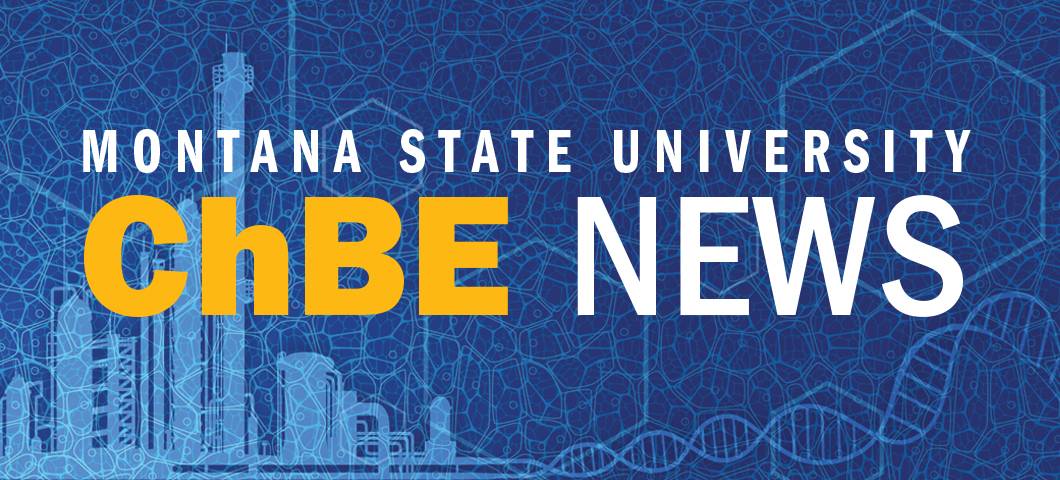2018 Newsletter
A PDF version of this newsletter is also available.
Accreditation, and giving thanks
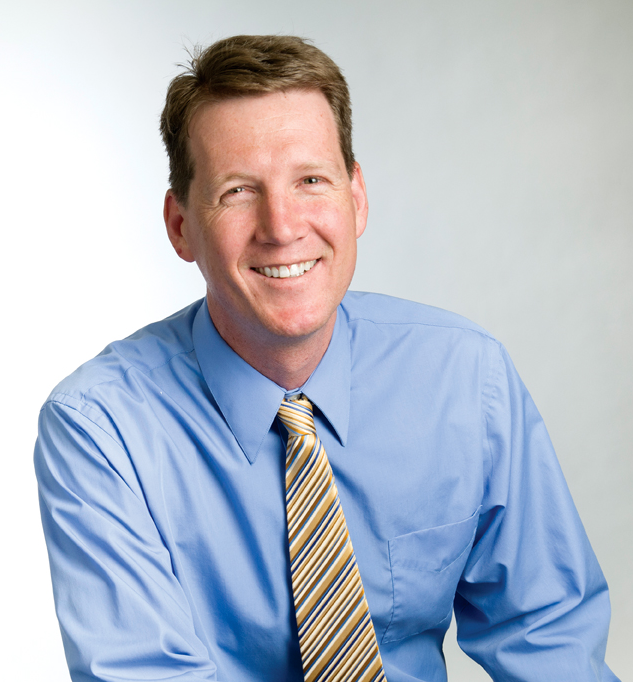
The Department of Chemical and Biological Engineering had an incredible year in 2017, thanks to our amazing students, hardworking faculty and incredible alumni. Many of my days were focused on preparing for the first-ever accreditation review of our biological engineering program. This program was initiated in 2007, but before we could apply for ABET accreditation, the program had to graduate students, assess the program and make changes based on the feedback — a process that took years.
Three representatives from ABET visited the department over a three-day period in September of 2017. They met with students, graduates, faculty and administrators from all over campus to determine whether we had a high-quality program that was producing high-quality graduates. The review went extremely well, and our biological engineering program was accredited with the best possible review rating — they did not find anything for us to fix!
When I reflect on 2017, the other thing that really stands out is the incredible support we received from our generous friends and alumni. We received a record amount of new scholarship support from a large number of different donors, but I want to highlight a few of these awards that were initiated this year: endowments supporting the Morman Family Scholarship, from Julie Morman, ’96, and family; the Standing Bear Chemical Engineering Scholarship from Jim Van Ness; and the Sam R. Uppala Scholarship. Also, the Raymond and Erin Schultz Fellowship for graduate students grew to be one of the largest endowments supporting graduate students at MSU. These endowments will be protected, and the interest they earn will support scholarships that will be given each year to some of our amazing students.
The generosity of these gifts continues to amaze me. As the parent of a middle school student and a high school student, I cannot thank all of our many donors enough. As the former recipient of a scholarship, I know first-hand that these scholarships will help our students focus more of their time and energy on learning so that they can better solve the problems that we need to solve.
Finally, I would like to close by thanking everyone who supported our department with another kind of gift: their time. Many alumni returned to MSU during the past year to talk with students about their careers, mentor them and hire them. The members of our Department Advisor Committee gave their time to help us continue to improve. Thank you all so much.
- Jeff Heys, ’96, Department Head
Student & Alumni News
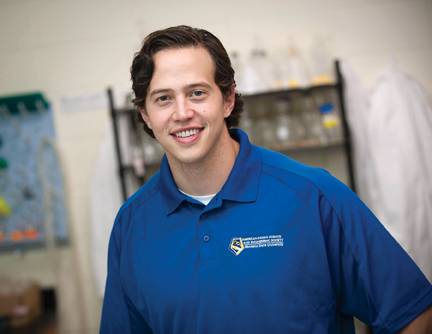
When Steven Davis graduated from the Montana State University’s Honors College, he opened the graduation celebration with a Blackfeet prayer. A meditation in the language of his ancestors gave expression to the role that his Native American heritage and faith have played in his accomplishments at MSU.
In addition to his honors degree, Davis played three years of basketball for MSU, and he earned bachelor’s degrees in biological and chemical engineering, with highest honors. Davis was an athlete, a scholar, a charismatic public speaker, an ambassador to tribal communities across Montana, an accomplished undergraduate researcher in the lab of Dr. Ross Carlson, and so much more. Ultimately, Steven was example that students do not have to focus on just a single pursuit, but they can flourish by pursuing a diverse range of interests.
During his senior year in high school, Davis was weighing academic scholarships from Stanford and Notre Dame. But his plans began to change after the MSU men’s basketball program asked him to come to campus for a scrimmage. Davis said his visit to Bozeman coincided with a family trip to the annual pow wow at MSU.
The excitement of that MSU weekend gave him a glimpse of a possible future, one that held the allure of playing NCAA Division I basketball and attending a top-notch engineering college on an academic scholarship, while remaining involved in the Native American community.
“I’ve never wanted to be recognized or recruited just for being Native American; I wanted to be recruited because of my own abilities and my own merits,” said Davis, an enrolled member of the Blackfeet tribe on his father’s side and an enrolled member of the Lower Brule Lakota of South Dakota through his mother’s family.
Davis joined the MSU basketball team in the fall of 2009. Including his redshirt freshman year, Davis was on the team for three years, all while juggling honors, undergraduate laboratory research and the dual major.
But Davis’ basketball career ended abruptly in the spring of 2012, when a collision in practice left him with a serious concussion.
Ross Carlson, Davis’ mentor and professor of chemical engineering, said there was concern the injury might derail his academic career.
Headaches, vision and working memory problems and reduced mental sharpness plagued him for more than a year. But Davis worked with his professors and MSU’s Office of Disability Services and eventually finished a raft of incomplete courses.
“A large percent of the population would have packed up and gone home,” said Carlson, who thought highly enough of Davis as a freshman to offer him a position in his lab, where he’s been researching the engineering of microbes for biofuels and bioplastics. “It’s hard enough to get a chemical engineering degree as it is. But he kept motoring and, despite his injury, got the bio (engineering) track completed, too.”
Davis’ hard work earned him his first job, as a process engineer with ExxonMobil in Baton Rouge, La. Davis is a second-generation MSU engineer, following in the footsteps of his father, Douglas Davis, who got his MSU degree in construction engineering and now works in Billings.
Davis also took on leadership roles in his extracurricular activities, serving as president of MSU’s chapter of the American Indian Science and Engineering Society and being involved with mentoring efforts through EMPower (Engineering Minority Program). His outreach efforts included traveling to visit students in far-flung tribal communities, telling them that they should ignore the story that they can’t succeed, or worse, that success in school is selling out.
“We’ve all heard that story, but it’s past time we write our own story and define our own success,” Davis said.
When he visited Browning, his ability to speak some Blackfeet and talk with reverence about his family’s history as holy women and men of the Thunder Medicine Pipe Society connects him to the community, said Darnell Rides at the Door, who is Davis’ aunt and an important elder. Rides at the Door teaches a traditional Indian studies class at the De La Salle Blackfeet School, a private Catholic school in Browning.
Davis’ commitment to others, particularly in helping strengthen the support networks for Native American students studying STEM (science, technology, engineering, math) disciplines, has left a legacy for students who follow, said Christine Foreman, director of EMPower and associate dean of student success in the College of Engineering.
“He is a big personality and he used that to get other students involved,” Foreman said.
Today, Steven continues to work with ExxonMobil, but he has transferred from Baton Rouge, La. to the ExxonMobil refinery in Billings, Montana. He now has the opportunity to return to MSU to recruit the next generation of Chemical and Biological Engineers to internships and full-time work at the Billings refinery. Steven continues to give back to Montana State University and he will always be a Bobcat.

Soon after he arrived at Montana State University as a Presidential Scholar from Lake Oswego, Oregon, Riley Shearer developed a philosophy to follow a path lit by passion, studying those subjects that truly interested him. That philosophy has led the senior, who will graduate from MSU in May with three distinct bachelor’s degrees, to a prestigious Schwarzman Scholarship for a year of study at Tsinghua University in Beijing.
Shearer is one of 129 scholars selected from an applicant pool of 2,747 candidates from 30 countries and 75 universities who will form the second class of Schwarzman Scholars, a highly competitive new scholarship developed by philanthropist Stephen A. Schwarzman, chairman, CEO and co-founder of Blackstone. Shearer is the first MSU student to receive a Schwarzman Scholarship, closely modeled on the Rhodes Scholar program.
“We at Montana State University are extraordinarily proud that Riley Shearer will represent Montana and our nation in an exemplary fashion within the international community of Schwarzman Scholars,” said MSU President Waded Cruzado. “Riley’s success is a testament to the abilities of a number of professors at MSU who have inspired this gifted student to blossom and achieve the highest of honors.”
Ilse-Mari Lee, dean of the MSU Honors College and one of Shearer’s mentors, said that Shearer, who currently has a perfect 4.0 GPA, will graduate summa cum laude from MSU with three separate bachelor’s degrees in chemical engineering in the College of Engineering, biochemistry in the College of Letters and Science, and economics in the College of Agriculture and the College of Letters and Science with a minor in mathematics as well as a degree from the MSU Honors College while gracefully managing a dizzying number of accomplishments and activities.
“We are very proud to call him our first Schwarzman Scholar and will follow his trajectory over the years with great interest,” Lee said.
Shearer credits his choice in attending MSU, as well as the mentors and quality of professors he has had at the university, including Lee, with his honors.
“When I first visited MSU, I got this vibe that there were so many opportunities for undergraduates here,” Shearer said, adding that while the offer of a Presidential Scholarship was vital, so were the opportunities to ski, climb and recreate in the nearby mountains. “That turned out to be true. I got lucky to come here. It has been the right place for me.”
When he first came to MSU, Shearer said he planned to major in biomedical engineering. As a freshman he was involved in research of nanoparticles in the lab of Trevor Douglas, a former MSU chemistry professor. That research, along with work with Stephanie McCalla in the Department of Chemical and Biological Engineering, led to a Goldwater Scholarship for Shearer, the country’s most prestigious undergraduate award honoring achievements in STEM fields.
While at MSU, Shearer has also volunteered with MSU’s Engineers Without Borders chapter, helping to bring clean water to the village of Khwisero, Kenya. He has been a student ambassador for both the College of Engineering and Honors College, and his research at MSU received support from Montana INBRE — an Institutional Development Award from the National Institutes of Health.
Faculty & Research News
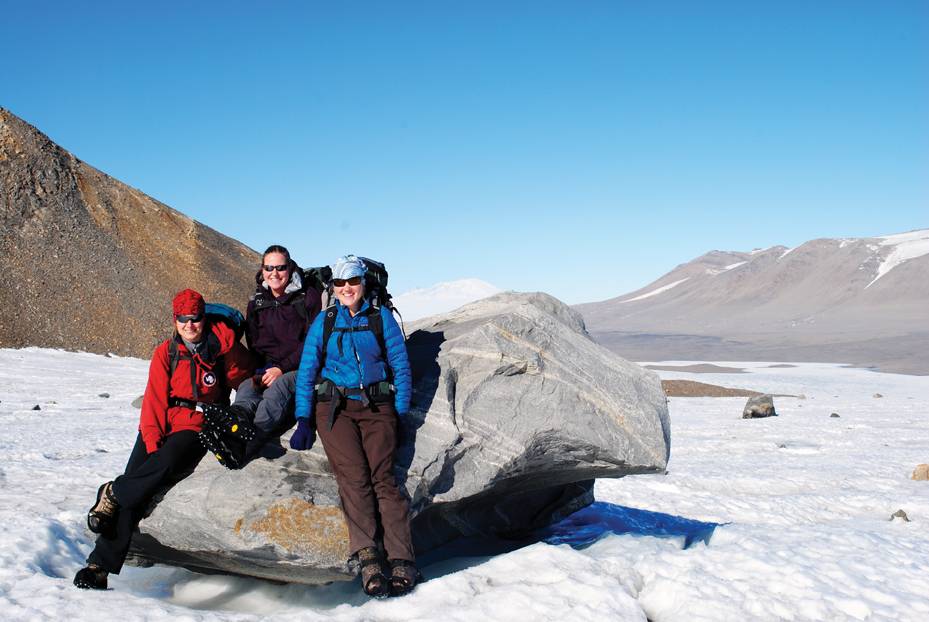
Two researchers in MSU’s Center for Biofilm Engineering have played a major role in discovering how microbial communities in melting glaciers contribute to the Earth’s carbon cycle, a finding that has global implications as the bulk of Earth’s glaciers shrink in response to a warming climate. Heidi Smith (right), a postdoctoral researcher, and Christine Foreman (center), associate professor of chemical and biological engineering were co-authors of a paper published in the prestigious journal Nature Geoscience. The paper challenges the prevailing theory that microorganisms found in glacial meltwater primarily consume ancient organic carbon that was once deposited on glacial surfaces and incorporated into ice as glaciers formed. “We felt that there was another side to the story,” said Smith, the paper’s lead author. “What we showed for the first time is that a large proportion of the organic carbon is instead coming from photosynthetic bacteria” that are also found in the ice and that become active as the ice melts, Smith said.
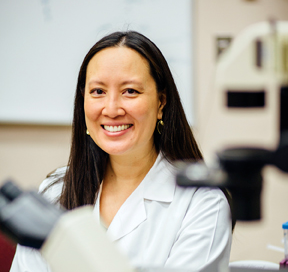
Connie B. Chang, assistant professor in the Department of Chemical and Biological Engineering, and her colleagues have received a $5.2 million grant to push the boundaries of a new approach for treating flu and other fast-evolving viruses that resist traditional vaccines. Chang’s team will receive $1.3 million of the funding, which was awarded by the Defense Advanced Research Projects Agency (DARPA), an independent agency of the U.S. Department of Defense that funds “high-risk, high-reward” projects. Chang and her team will explore the use of a sophisticated method called drop-based microfluidics for producing therapeutic interfering particles, or TIPs, for treating influenza. “Once we understand how this applies to flu, we could potentially use this method to make TIPs for other viruses,” Chang said. DARPA lists more than 40 “high priority viral pathogens,” including Ebola, HIV and Zika, as candidates for treatment using TIPs.
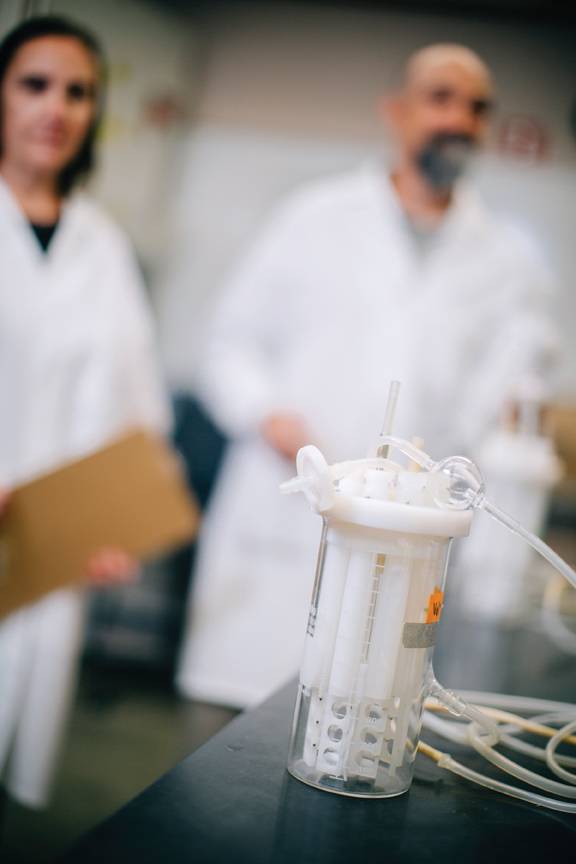
More than a decade of work by Montana State University researchers will soon help hospitals and other consumers select disinfectants that are effective against a wider range of bacteria. Recommendations provided by MSU’s Center for Biofilm Engineering were the scientific backbone for new antimicrobial testing standards that the U.S. Environmental Protection Agency released in July, according to Darla Goeres, an associate research professor in the Department of Chemical and Biological Engineering. “This is a massive milestone,” she said. The standards are the first ever that apply specifically to bacteria that form biofilms —thin, slimy layers that can make microbes more resistant to traditional disinfectants. The standards provide a certification framework for companies to verify that their products are effective against biofilm bacteria and to label them accordingly, with a statement similar to the “Kills 99.9% of bacteria” found on bottles of bleach and other cleaners. The new labels could appear on products within a year, Goeres said.

A team led by Stephanie McCalla, assistant professor in the Department of Chemical
and Biological Engineering, is working to develop a new technology that could make diagnosis of malaria and other diseases more accessible, potentially improving treatment for millions of people in areas with limited medical
resources. The project will apply recent findings about the disease-detecting potential
of microRNA — small molecules that regulate a variety of cellular functions in the
body. MicroRNA was discovered in the 1990s, and recent research has indicated that
the body produces microRNA molecules specific to a disease when it is battling the
ailment. But emerging efforts to use microRNA for diagnosis require cumbersome and
expensive technology found only in specialized labs, according
to McCalla. “We want to develop a method that’s easy and one-step in the field,” she
said. Ideally, a small device would use a small blood draw to make an accurate diagnosis
within an hour. The research is focused on malaria and tuberculosis. But the technology
could be applied to a variety of diseases and disorders, including heart disease and
depression, she said.
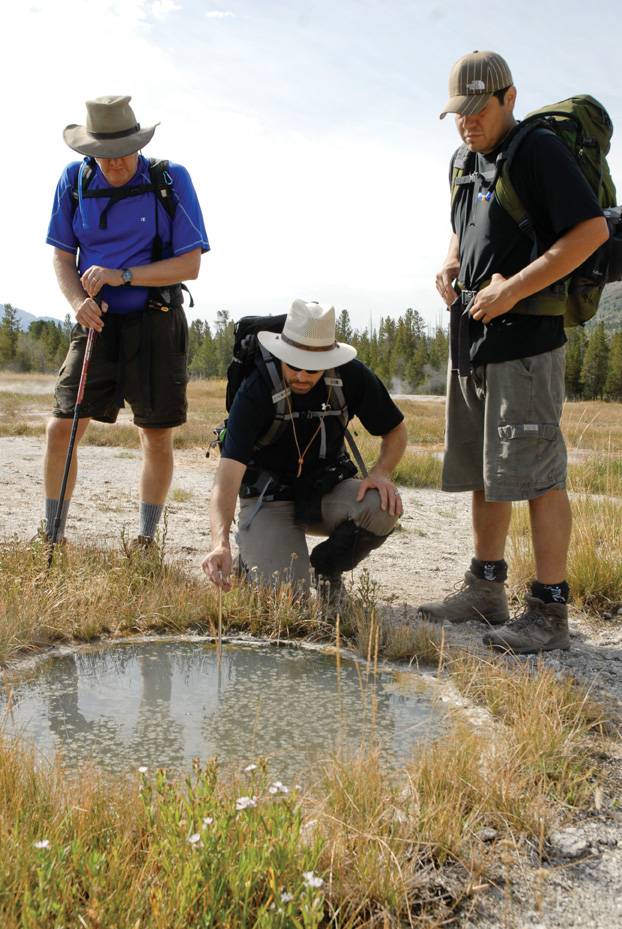
A research team that includes several faculty in the Chemical and Biological Engineering Department has received $1.8 million from the National Science Foundation for a collaborative project to study methane-consuming microbes and develop ways of using them to make commercial products such as plastics. The project’s abbreviated name is BuG ReMeDEE (pronounced “bug remedy”, an abbreviation for Building Genome-to-Phenome Infrastructure for Regulating Methane in Deep and Extreme Environments), which alludes to where the researchers will look for the microbes: in the thermal features of Yellowstone National Park and underground in a former South Dakota gold mine. “It’s not well understood what organisms are involved in the conversion of methane in these environments,” said Robin Gerlach, a professor in the Chemical and Biological Engineering Department and the project’s principal investigator at MSU. The team also includes chemical and biological engineering professors Connie Chang, Jim Wilking and Ross Carlson.
MSU Photos by Kelly Gorham, Adrian Sanchez-Gonzalez or Sepp Jannotta unless otherwise noted
Are you interested in making a gift to the Department of Chemical and Biological Engineering? If so, please go to http://foundation.montana.edu/chbe.
Department of Chemical and Biological Engineering P.O. Box 173920 Bozeman, MT 59717-3920
Parting Shot
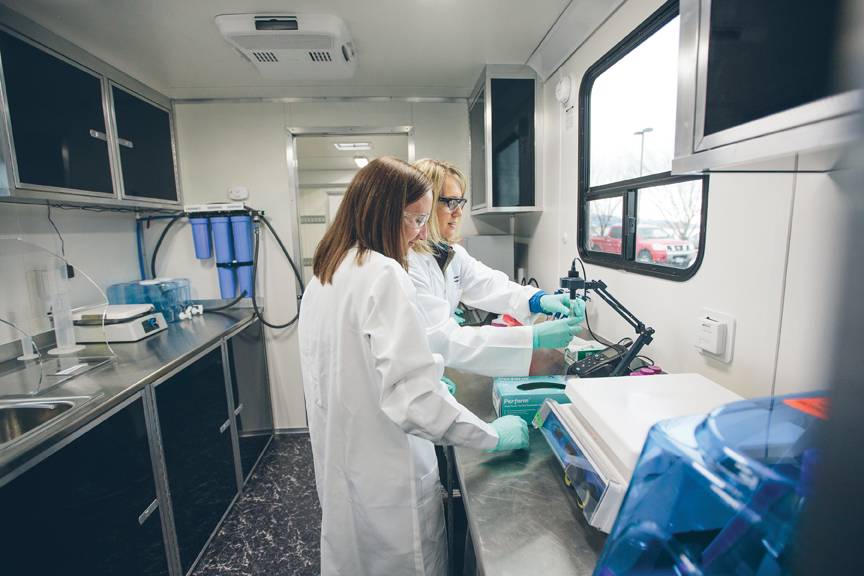
Researchers in the Center for Biofilm Engineering run a test of equipment inside a mobile laboratory at MSU. The mobile unit is being used at multiple field sites across the country this year to advance a new technology for repairing leaking oil and gas wells using rock-forming bacteria.

